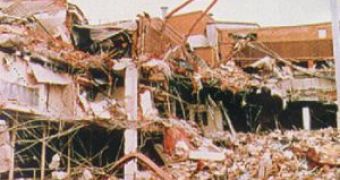People have reached to consider themselves Gods in many ways, but now they trigger even earthquakes. Unfortunately, unwittingly and in the most undesired places.
The greatest earthquake in Australia's history - that reached 5.6 in magnitude - was a human opera. It struck Newcastle (photo), in New South Wales, on December 28, 1989, killing 13 people, injuring 160, and provoking damages estimated to 3.5 billion U.S. dollars. Tectonic changes, due to 200 years of underground coal mining, were the trigger. "The quake wasn't enormous, but Australia isn't generally considered to be seismically active and the city's buildings weren't designed to withstand a temblor of that magnitude", said Christian D. Klose of Columbia University's Lamont-Doherty Earth Observatory in Palisades, New York. "All told, the monetary damage done by the earthquake exceeded the total value of the coal extracted in the area."
"The removal of millions of tons of coal from the area caused much of the stress that triggered the Newcastle quake," Klose said. Even so, groundwater pumped out to keep the mines from flooding may have played a greater role. "For each ton of coal produced, 4.3 times more water was extracted," Klose said. "Other mining operations sometimes require as much as 150 tons of water to be removed for each ton of coal produced."
Coal mining isn't the only human activity that can trigger earthquakes. Besides coal mining, Klose has identified other causes, too, for more than 200 man-made quakes, mostly in the past 60 years. "Most were caused by mining, he said, but nearly one-third came from reservoir construction."
"Oil and gas production can also trigger earthquakes," he added. "Three of the biggest human-caused earthquakes of all time, he pointed out, were a trio that occurred in Uzbekistan's Gazli natural gas field between 1976 and 1984."
The three had a magnitude between 6.9 to 7.3. "Human-triggered earthquakes are particularly dangerous, Klose said, if they occur in seismically inactive areas." People of those areas aren't prepared for quakes and "regions that are naturally inactive are very trigger-sensitive, because stress has built up over long periods of time."
Scientists look for a measure to reduce the risk of quakes by mining. "One way would be to find a way that doesn't reduce the water in the mine," Klose said. The proposals to get rid of global warming provoking carbon dioxide by injecting it into geologic formations deep underground where the gas cannot escape seem unfortunate. "That alters stress in the crust [too]," Klose said. "Don't put the injection fields close to large cities."
"The research could also have an impact on earthquake-insurance premiums", said Andr? Unger of the University of Waterloo, in Ontario. Underground carbon sequestration is a knife with two cuts: it could decrease the risk of some types of damage provoked by global warming, like hurricanes, while increasing the risk of earthquakes.

 14 DAY TRIAL //
14 DAY TRIAL //